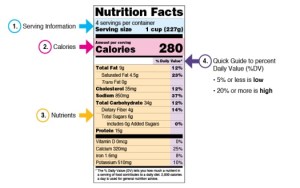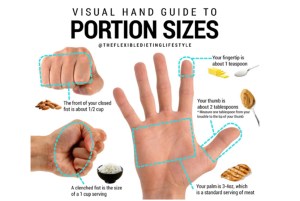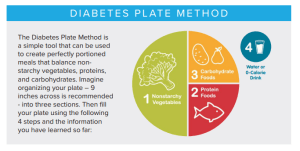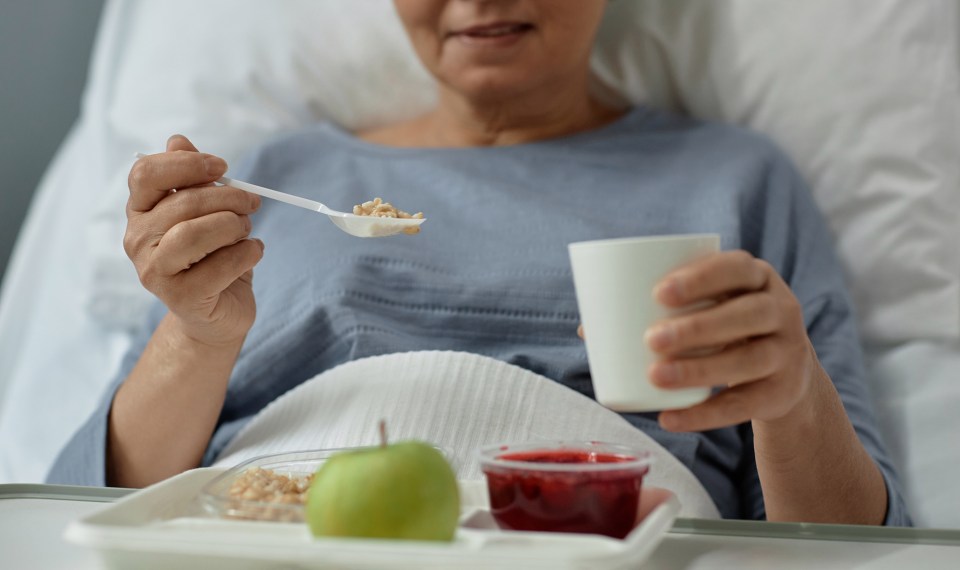Healthy eating and meal planning for diabetics can seem complicated, but it doesn’t have to be. Try these practical tips to eat well and keep your blood sugar levels in a healthy range. Consult your physician before making any changes to your diet.
Familiarize yourself with Nutrition Labels

Understanding nutrition labels is key to meal planning for diabetics. Dietitian Alyssa Crouch encourages her patients to practice mindfulness when meal planning and eating. “There’s no foods you can’t eat,” she said. “It’s about being mindful of your whole plate and your entire day.”
Here are a few things to keep in mind when reading food labels:
Recommended serving size: Look for the serving size at the top of the label, especially how many servings are in a full package or container. A full container often has more than one recommended serving. “A bag of chips could have five servings so be mindful of the serving size,” Crouch said.
Calories: To maintain your weight, calorie intake should be balanced with calorie output; 1,600-2,400 per day is often a good standard. To lose weight, calorie intake should be less than calorie output.
Nutrients: The largest section on nutrition labels is often the nutrients section. Pay special attention to total carbohydrates, dietary fiber, and total and added sugars.
- There are three main types of carbohydrates: starches sugars, and fiber. Carb consumption increases blood sugar levels. Therefore, counting carbohydrates eaten throughout the day is important for managing diabetes.
- Diets that are high in fiber can help normalize bowel movements and prevent constipation, control blood sugar levels and lower the risk of heart disease and some forms of cancer.
- Too much sugar is related to weight gain, fatigue, high blood pressure and heart disease among many other possible health risks.
Tip: If you are not currently eating foods high in fiber, it is recommended that you slowly increase your intake, so your body can adjust.
Percent Daily Value: Also referred to as %DV is the percentage of nutrients in one serving of food when compared to the total number of each nutrient recommended per day. Percentages on food labels are based on a 2,000 calorie adult diet.
Tip: Remember to choose foods with higher %DV for dietary fibers, vitamin D, calcium, iron, and potassium and lower %DV for saturated fat, sodium and added sugars.
Refer to this ‘Handy’ Visual

Meal planning for diabetics can hit a snag when you don’t have a food scale or measuring tools nearby. Whether you’re preparing your own food or enjoying a meal out, use this visual resource for understanding common serving sizes using only your hand as a guide.
Use the Diabetics Plate Method
The Diabetics Plate Method is a simple tool that can be used to create perfectly portioned meals that balance non-starchy vegetables, proteins and carbohydrates.
Imagine organizing your plate—9 inches across is recommended—into three sections.
1. Fill half your plate (50%) with non-starchy vegetables. They are low in carbohydrates and, therefore, do not increase blood sugar much. The bonus is that they are also high in vitamins and dietary fiber. Crouch advises her patients to make eating vegetables a habit. “Try to get one vegetable with lunch and dinner. Incorporate them into your diet so that it becomes part of your lifestyle and you’re not even thinking about it,” she said.

Examples: asparagus, broccoli, cauliflower, brussel sprouts, cabbage, carrots, celery, cucumber, leafy greens, salad greens, mushrooms, green beans, tomatoes, spaghetti or zucchini squash.
Tip: Eat the rainbow. Try to get as many colorful vegetables and fruits in your diet.
2. Fill one quarter (25%) of your plate with lean protein. Protein is important for building muscle and helping to stay full. It also contains less saturated fat, which can decrease the risk of heart disease.
Examples: Chicken, turkey, eggs, salmon, tuna, tilapia, cod, shrimp, scallops, clams, lobster, lean beef cuts (i.e. chuck, round, sirloin, flank, tenderloin), lean pork cuts (i.e. center loin, chop, tenderloin), lean deli meats, cheese and cottage cheese. Plant-based proteins include beans, lentils, humus, falafel, nuts, nut butters, edamame, tofu, tempeh and plant-based meat substitutes.
3. Fill one quarter (25%) of your plate with carbohydrates. Limiting how many carbohydrates you eat can help prevent blood sugar levels from rising too high after meals.
Examples of healthy carbohydrate foods: brown rice, quinoa, wheat bread, whole grain pasta, tortillas, starchy vegetables (i.e. butternut squash, peas, plantain, potato, sweet potato, yam), beans (i.e. black, kidney, pinto, garbanzo/chickpeas), fruits, dried fruits and dairy products (i.e. milk, yogurt, milk substitutes).
Tip: Try to get as many whole, minimally processed starches into your diet as possible. When reading the ingredient list on nutrition labels, look for products that list “whole grain” or “whole wheat” as the first ingredient rather than products that have “enriched” ingredients.
4. Choose water or low-calorie drinks. Water is the best choice because it contains no calories or carbohydrates—therefore having no effect on blood sugar.
Examples of other zero- or low-calorie options: unsweetened tea, unsweetened coffee, sparkling water without sugar, club soda and flavored water.
Stick to a Schedule
There are several ways to simplify your shopping and meal preparation. Crouch points out that keeping a schedule is helpful. “For making meal plans simpler, pick a day each week that you will sit down and plan out your meals. As you are meal planning, put together a grocery list,” she said. Other ways to streamline your meal planning include:
- If your budget allows, purchase pre-cut fruits and vegetables either raw or frozen to save time.
- Select precooked grains like rice and quinoa.
- Cook a few larger dishes on a day when you have more time and eat it over the course of a few days instead of cooking a meal each day.
- Cook a larger portion of a healthy protein like chicken and use it for a few different recipes throughout the week.
Dine Out with Confidence
Dining out can make meal planning for diabetics difficult. Restaurant portions are up to three to four servings and the menus boast an array of fatty, fried foods. Don’t let that stop you. There’s always healthier options, even at fast food establishments. Remember to:
- Limit portion size: Use the 80/20 rule: When you feel 80% full, stop eating.
- Choose grilled meats over fried.
- Choose salad over french fries.
- Choose whole-wheat versus white when ordering sandwiches, pastas and rice dishes if possible.
- Choose low-fat dressing and be mindful of added sugar.
- Add extra vegetables to dishes when possible.
Tip: Eat your vegetables first when it’s convenient. Recent studies show that eating foods in the right order can reduce the glucose spike of a meal by 74% and insulin spike up to 48%. Vegetables first. Proteins and fat second. Starches and sugars last.
Download this Free Simple Guide
Want more? Download Simple Health, a healthy eating for diabetics guide. In it you’ll find:
- More information about food labels
- A guide to carbohydrate counting
- Additional nutrition tips
- Diabetic-friendly snacks
- Recipes and more!
The content of this site is for informational purposes only and should not be taken as professional medical advice. Always seek the advice of your physician or other qualified healthcare provider with any questions you may have regarding any medical conditions or treatments.



